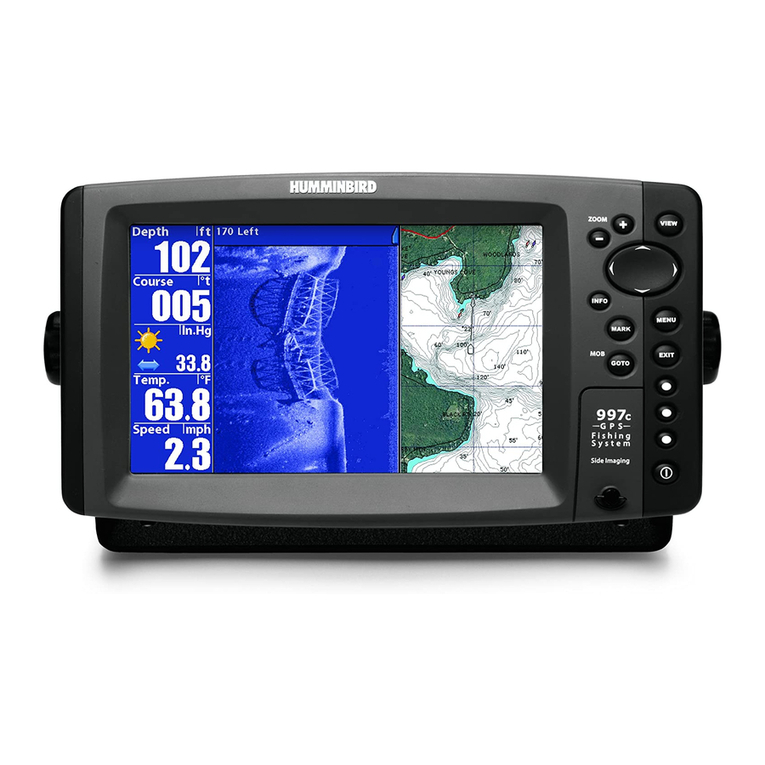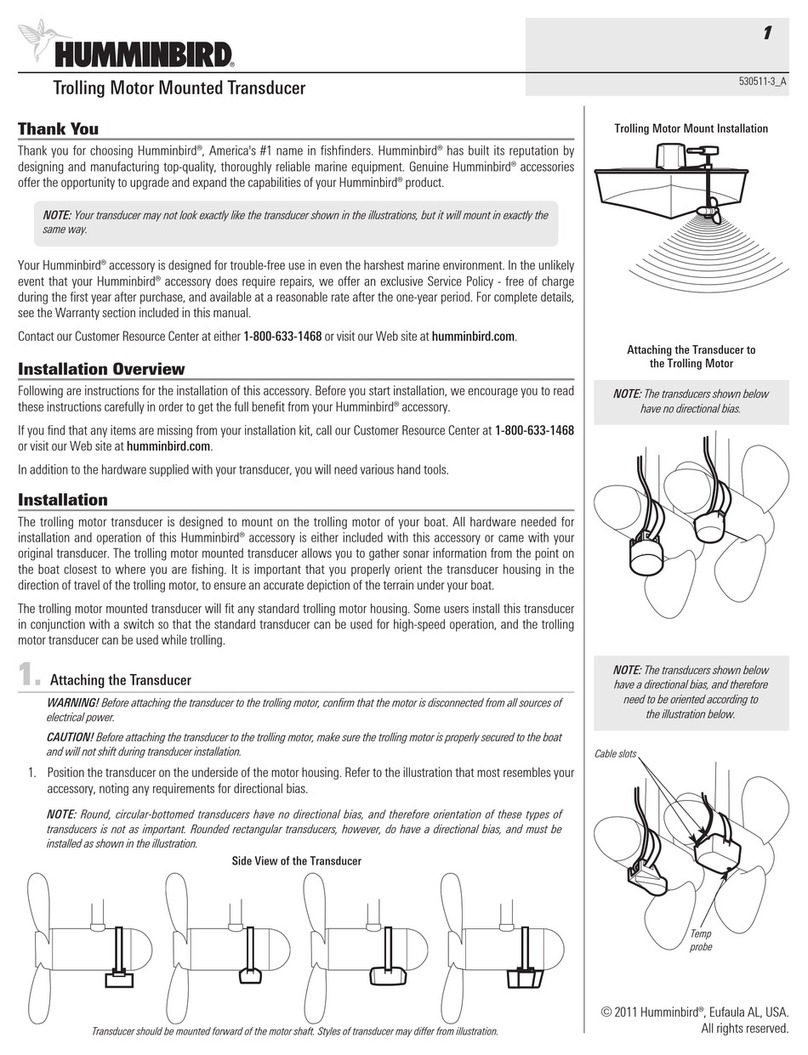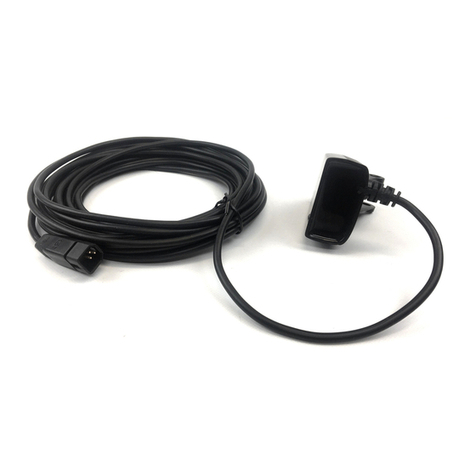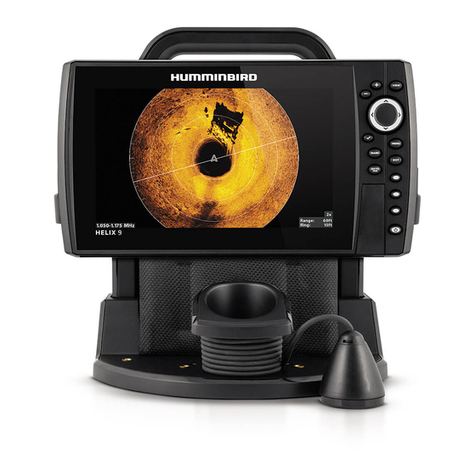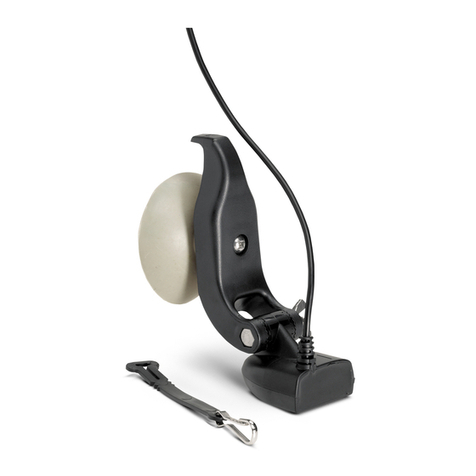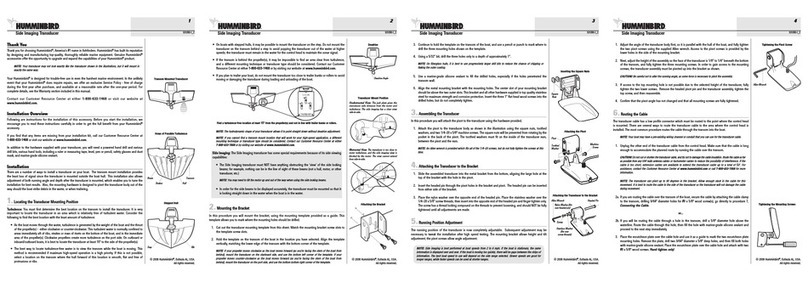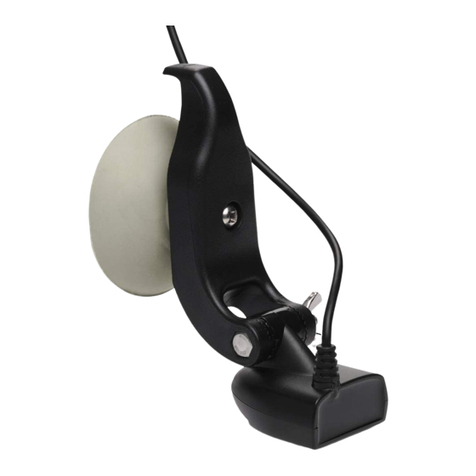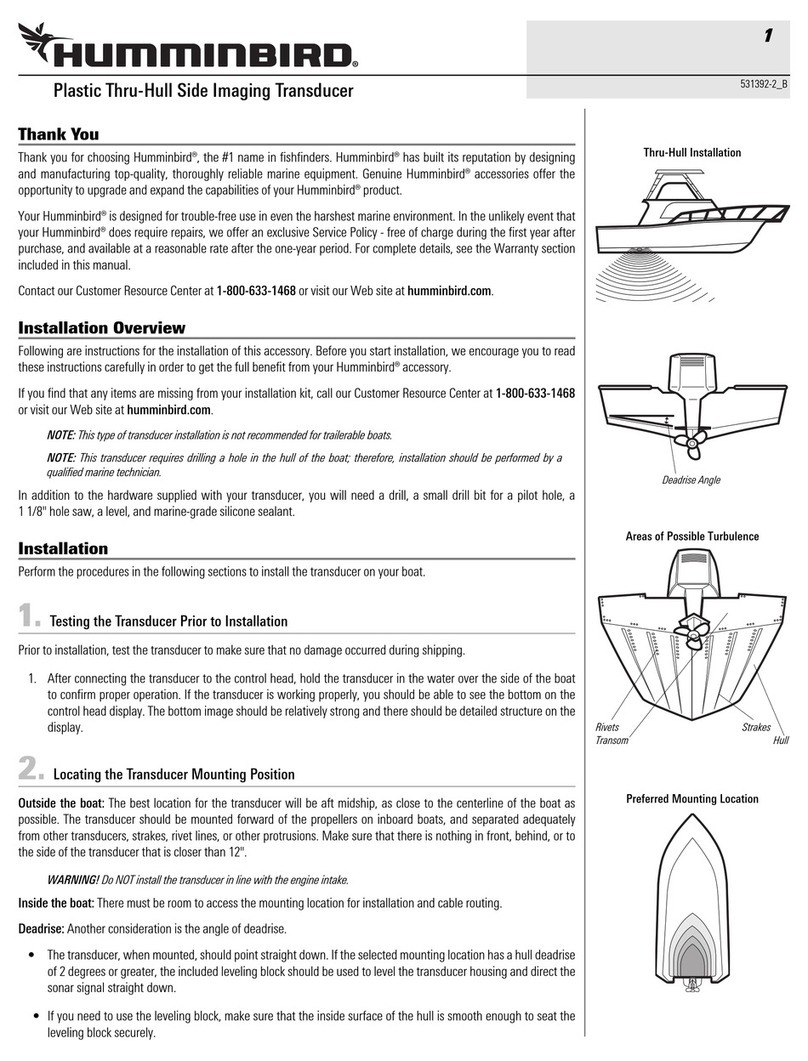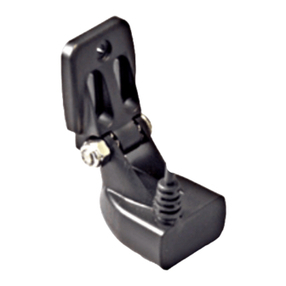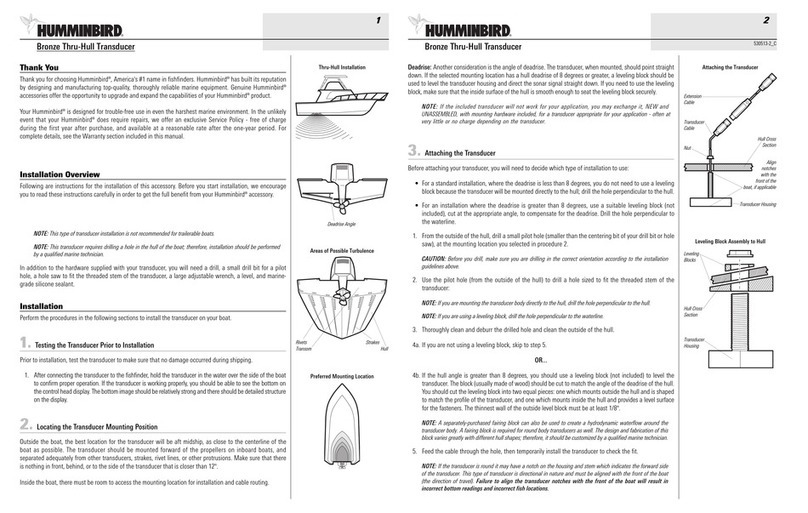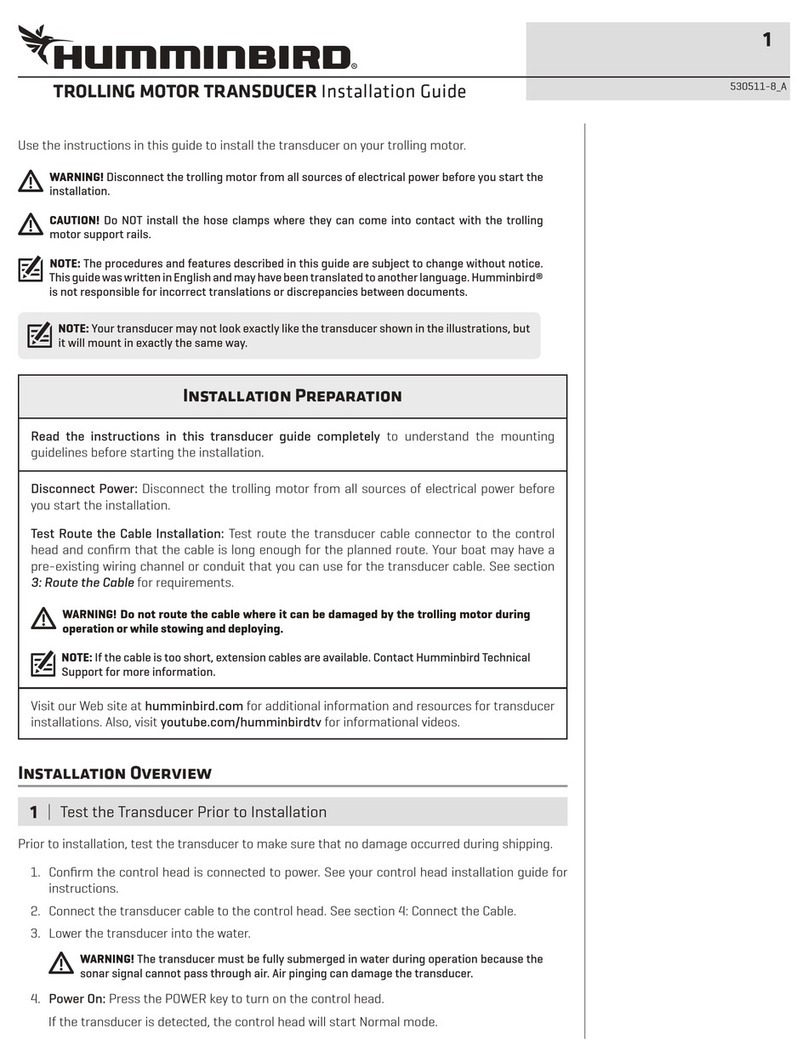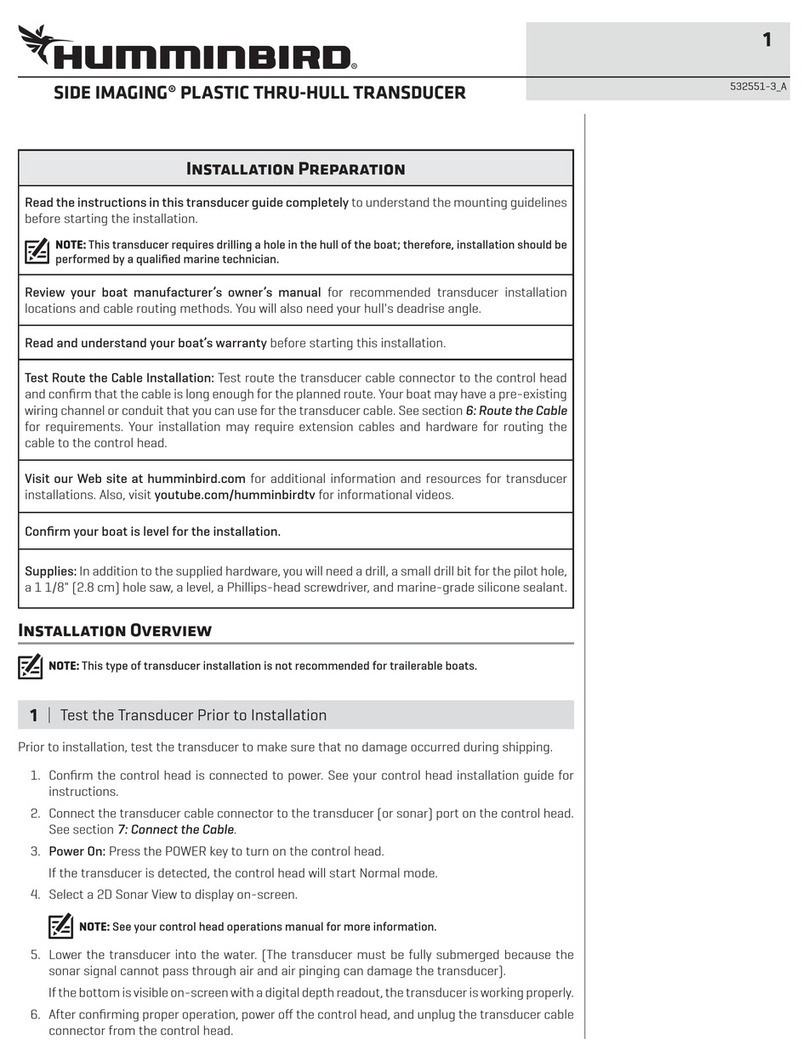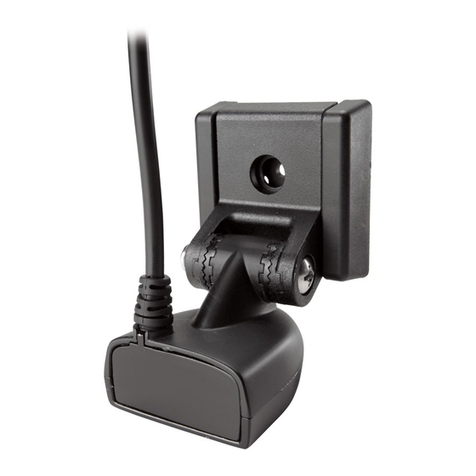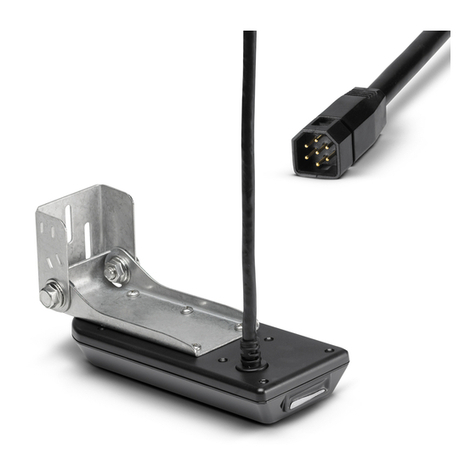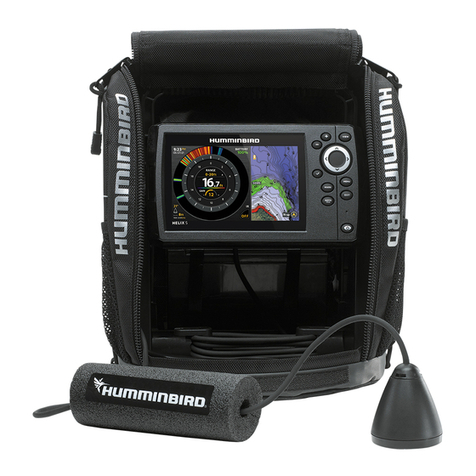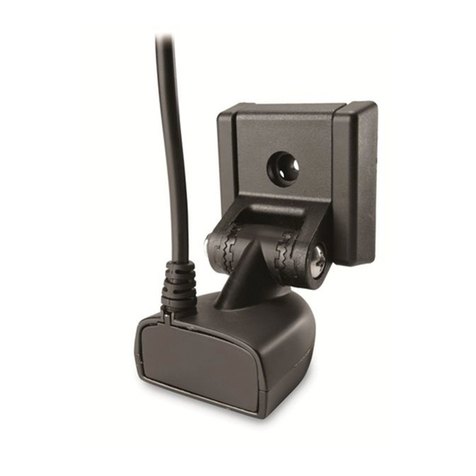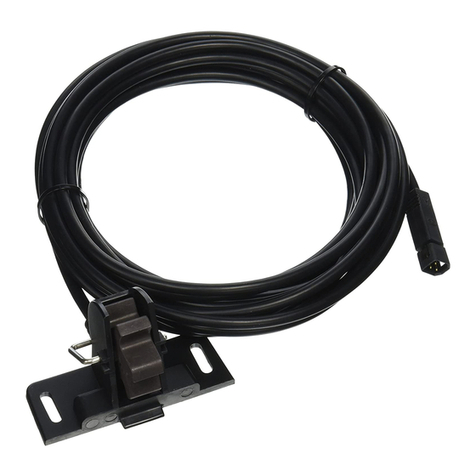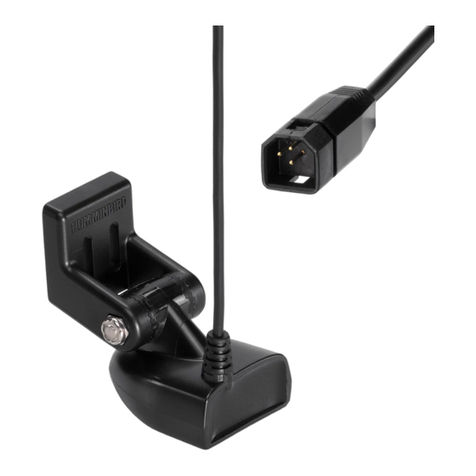
5. Press the R GHT or LEFT Cursor keys to select the transducer type (Dual
Beam, Quad Beam, etc.). The available menu options will depend on the
transducer model you have attached.
6. Close: Press the EX T key until the Menu System is closed. Your
control head is now ready for operation.
Maintenance
f your boat remains in the water for long periods of time, algae and other
marine growth can reduce the effectiveness of the transducer. Periodically
clean the face of the transducer with hot water.
f your boat remains out of the water for a long period of time, it may take
some time to wet the transducer after it is returned to the water. Small air
bubbles can cling to the surface of the transducer and interfere with proper
operation. These bubbles will dissipate with time, or you may wipe the face of
the transducer with your fingers after the transducer is in the water.
1-Year Limited Warranty
We warrant the original retail purchaser that products made by Humminbird®
have been manufactured free from defects in materials and workmanship.
This warranty is effective for one year from the date of original retail
purchase. Humminbird® products found to be defective and covered by this
warranty will be repaired or replaced free of charge at Humminbird’s option
and returned to the customer freight prepaid. Humminbird’s sole
responsibility under this warranty is limited to the repair or replacement of a
product that has been deemed defective by Humminbird®. Humminbird® is
not responsible for charges connected with the removal of such product or
reinstallation of replaced or repaired parts.
This warranty does not apply to a product that has been:
• mproperly installed;
• Used in an installation other than that recommended in the product
installation and operation instructions;
• Damaged or has failed because of an accident or abnormal operation;
• Repaired or modified by entities other than Humminbird®.
Please retain your original receipt as a proof of the purchase date. This will be
required for in-warranty service.
TH S WARRANTY S EXPRESSLY N L EU OF ANY OTHER WARRANT ES,
OBL GAT ONS OR L AB L T ES ON THE PART OF HUMM NB RD® AND W LL BE
THE CUSTOMER'S EXCLUS VE REMEDY, EXCEPT FOR ANY APPL CABLE
MPL ED WARRANT ES UNDER STATE LAW WH CH ARE HEREBY L M TED N
DURAT ON TO ONE YEAR FROM THE DATE OF OR G NAL PURCHASE. N NO
EVENT W LL HUMM NB RD® BE L ABLE FOR ANY NC DENTAL OR
CONSEQUENT AL DAMAGES FOR BREACH OF ANY EXPRESS OR MPL ED
WARRANTY RELAT NG TO THE PRODUCTS.
Some states do not allow limitations on an implied warranty, or the exclusion
of incidental or consequential damages, so the above exclusions may not
apply to you. You may also have other rights, which vary from state to state.
Humminbird® Service Policy
Even though you'll probably never need to take advantage of our incredible
service policy, it's good to know that we back our products this confidently.
We do it because you deserve the best. We will make every effort to repair
your unit within three business days from the receipt of your unit at our
factory. This does not include shipping time to and from our factory. Units
received on Friday are typically shipped by the following Wednesday, units
received Monday are typically shipped by Thursday, etc.
All repair work is performed by factory-trained technicians to meet exacting
factory specifications. Factory-serviced units go through the same rigorous
testing and quality control inspections as new production units.
After the original warranty period, a standard flat rate service charge will
be assessed for each repair (physical damage and missing parts are not
included). Any repairs made after the original warranty will be warranted
for an additional 90 days after service has been performed by our factory
technicians. You can contact our Customer Resource Center or visit our
web site to verify the flat rate repair fee for your product (visit the Product
Support section):
http://www.humminbird.com
We reserve the right to deem any product unserviceable when
replacement parts are no longer available or impossible to obtain. This
Service Policy is valid in the United States only. This applies only to
Humminbird® products returned to our factory in Eufaula, Alabama. This
Service Policy is subject to change without notice.
DOMESTIC (USA) CUSTOMERS:
PLEASE DO NOT RETURN THIS PRODUCT TO STORE FOR SERVICE
For all technical issues please call 1-800-633-1468
or visit www.humminbird.com, click S PPORT.
Please reference product serial number and
model number when contacting Humminbird®.
Plastic Thru-Hull Transducer
4
530758-4_A
CAUTION! To avoid damage, do not overtighten the nut.
9. Remove the excess adhesive sealant from the outside of the hull to ensure smooth water flow over the
transducer.
4. Routing the Cable
The transducer cable must be routed to the point where the control head is mounted.
NOTE: Your boat may have a pre-existing wiring channel or conduit that you can use for the transducer cable.
1. Unplug the other end of the transducer cable from the control head.
CAUTION! Do not cut or shorten the transducer cable, and try not to damage the cable insulation. Route the cable as far
as possible from any VHF radio antenna cables or tachometer cables to reduce the possibility of interference. If the cable is
too short, extension cables are available to extend the transducer cable up to a total of 50'. For assistance, contact the
Customer Resource Center at humminbird. om or call 1-800-633-1468 for more information.
CAUTION! Do N T mount the cables where the connectors could be submerged in water or flooded. If cables are installed
in a splash-prone area, it may be helpful to apply dielectric grease to the inside of the connectors to prevent corrosion.
Dielectric grease can be purchased separately from a general hardware or automotive store.
2. Route and secure the cable, avoiding areas where it may be damaged or interfere with normal boating
operations.
5. Connecting the Cable
Refer to your manual and/or control head installation guide for the correct procedure for installing the cable
connectors to the control head. Whether through the cable collector or directly to the control head, insert the
transducer cable connector into the appropriate slot or port. The cable connectors are labeled, and there are
corresponding labels on the cable collector and control head. The connectors are keyed to prevent reversed
installation, and insertion should be easy— do not force the connectors into the ports.
NOTE: If the connector on the cable is round, it has a screw nut (see the illustration Transdu er Conne tors). Hand
tighten the screw nut to secure the cable connection. Hand tighten only!
6. Setting up the Transducer on the Control Head
Use the following instructions to set the transducer type in the control head. When you select the transducer type,
the related views and menus will be added to the system. Before you proceed, review the following information:
• f your transducer has the round connector, see your Humminbird® control head operations manual to set up
the transducer sources on the control head. The instructions in this section do not apply to your fishing system.
• f your fishfinder is a PiranhaMAX, or does not include the Transducer Select or Connected Transducer menu
option, no further action is required. The transducer will be detected automatically if it is compatible with the
control head. See your control head operations manual for details.
• f the transducer you've purchased is not compatible with your Humminbird® control head, the unit will not
function properly. Visit our Web site at humminbird.com to find compatible transducers for your Humminbird®
model.
1. Press the POWER/L GHT key to power on the control head.
2. Press the MENU key. When the control head detects a functioning transducer, it will automatically enter Normal
operating mode. Follow the on-screen prompts.
3. Main Menu: Press the Menu key twice.
4. Use the 4-WAY Cursor Control key to select the Sonar tab > Transducer Select or Connected Transducer.
Plastic Thru-Hull Transducer
3
530758-4_A
3. Attaching the Transducer
Before attaching your transducer, you will need to decide which type of installation to use:
• For a standard installation, where there are no major obstructions and the deadrise is less than 8 degrees, use
the included leveling block (uncut), and mount it inside the hull. Drill the hole perpendicular to the hull.
• For an installation that needs to minimize the impact of a small obstruction, but where the deadrise is less than
8 degrees, use the included leveling block (uncut), and mount it outside the hull. Drill the hole perpendicular to
the hull.
• For an installation where the deadrise is greater than 8 degrees, use the included leveling block, cut at the
appropriate angle, to compensate for the deadrise. Drill the hole perpendicular to the waterline.
1. From the outside of the hull, drill a small pilot hole (smaller than the centering bit of your drill bit or hole saw), at
the mounting location you selected in procedure 2.
CAUTION! Before you drill, make sure you are drilling in the correct orientation according to the installation guidelines
above.
2. Use the pilot hole (from the outside of the hull) to drill a 1 1/8" hole that is sized to fit the threaded stem of
the transducer:
NOTE: For installations where the deadrise is less than 8 degrees, where you will not be cutting the leveling block, drill the
hole perpendicular to the hull.
NOTE: For installations where the deadrise is greater than 8 degrees, and you will be cutting the leveling block at an angle,
drill the hole perpendicular to the waterline.
3. Thoroughly clean and deburr the drilled hole and clean the outside of the hull.
4a. If the deadrise is less than 8 degrees, you will not be cutting the leveling block; install it either on the inside of
the hull (standard installation) or on the outside of the hull to compensate for small obstructions.
OR...
4b. If the hull angle is greater than 8 degrees, you should cut the included leveling block and use both pieces to
level the transducer. The block should be cut to match the angle of the deadrise of the hull. The leveling block
included with your transducer can accommodate a maximum deadrise angle of 25 degrees.
CAUTION! Use only the leveling block included with this transducer. Do N T use a wooden leveling block, as any swelling
of the wood might cause the plastic on the transducer to shatter.
NOTE: You should cut the leveling block into two equal pieces: one which mounts outside the hull and is shaped to match
the profile of the transducer, and one which mounts inside the hull and provides a level surface for the fasteners. The
thinnest wall of the outside leveling block must be at least 1/8".
NOTE: A separately-purchased fairing block can also be used to create a hydrodynamic waterflow around the transducer
body. The design and fabrication of this block varies greatly with different hull shapes; therefore, it should be customized by
a qualified marine technician.
5. Feed the cable through the hole, then temporarily install the transducer to check the fit.
6. Apply a generous amount of marine-grade silicone sealant or slow-curing epoxy inside the drilled hole and along
the mating surfaces of the transducer housing. Also, seal the mating edges of the leveling block.
7. Make sure that the narrow (thin) end of the transducer is pointing forward. nsert the transducer into the drilled
hole from outside the boat, then install the nut onto the threaded stem from inside the boat.
NOTE: This type of transducer is directional in nature and must be aligned with the front of the boat (the direction of travel)
and parallel to the center line. Failure to align the transducer properly will result in incorrect bottom readings and incorrect
fish locations (see the illustration Corre t Orientation of Transdu er).
8. Hand tighten the nut ONLY until the assembly is firmly seated, then tighten NO MORE than 1/8 of a turn extra.
Cut-leveling blocks
Hull
Apply Marine Adhesive
Sealant to all mating surfaces
1/8"
Minimum
thickness
Leveling block (can
also be positioned
outside of the hull)
Hull
Installation for deadrise angle greater than 8°,
using a cut leveling block to level transducer.
Standard Installation
Apply Marine Adhesive
Sealant to all mating surfaces
Correct Orientation of Transducer
Plastic Thru-Hull Transducer
Transducer Connectors
Hexagon-Shaped
Connector
Round
Connector
Screw
Nut
530758-4_A copy.qxp:530758-3_B 11/14/12 8:08 PM Page 2
